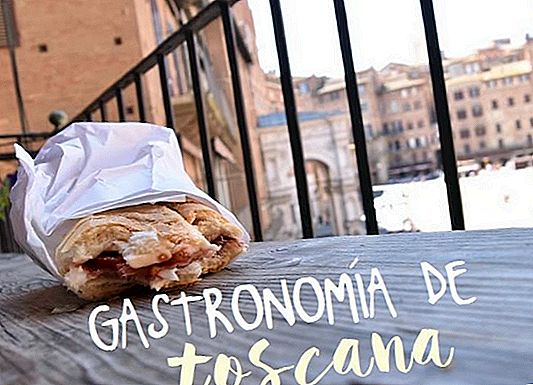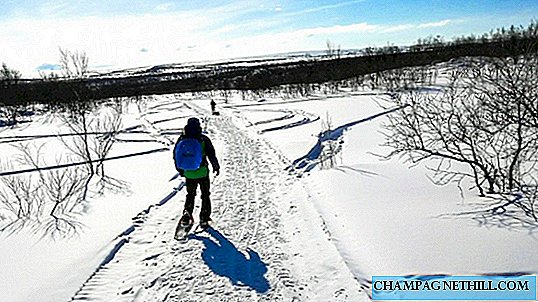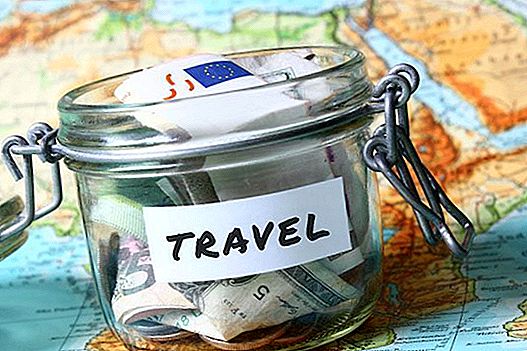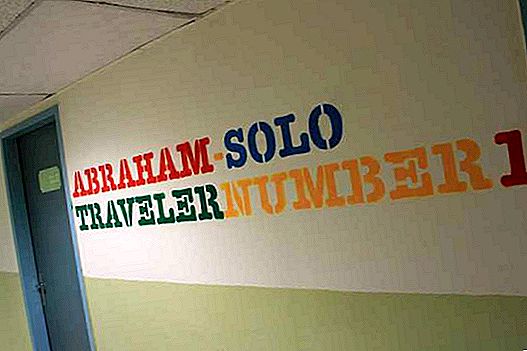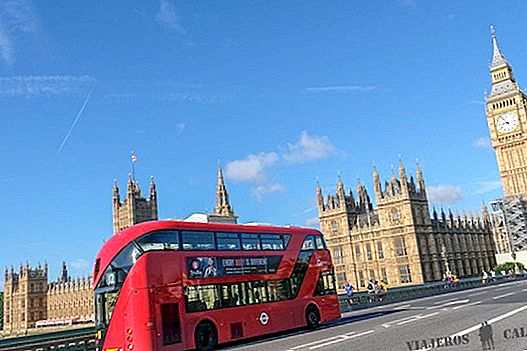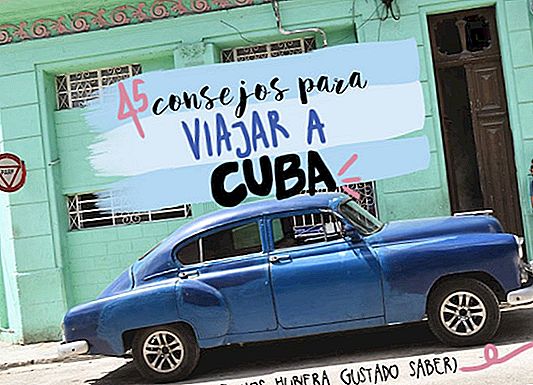
We confess that the trip to Cuba was one of the least prepared we ever did: we arrived from the United States where we spent two months and we had enough to try to organize our day to day there. So this article is designed to help everyone who wants to travel to Cuba, need advice or want to know what awaits them.
Marching 45 tips for traveling to Cuba (or everything we would have liked to know before traveling).
1. Cuba is a very peculiar place, with a personality so strong that it may leave you somewhat stunned ... to try to understand it you have to know its history. Here is a post with a (not so) brief summary of the history of Cuba 😉
2. A basic itinerary It needs a minimum of 15 days and could be the following: Havana (2 days) - Trinidad (2 days) - Santa Clara (1 day) - Cayo Santa María (3 days) - Varadero (3 days) - Viñales (2 days) ) - Havana (1 day).
3. If you have more time (recommended!) We advise you to visit the south of the island (Camaguey, Santiago de Cuba, Guardalavaca, ...).
4. Do I need visa to travel to Cuba? The answer is yes! Although in reality it is a “Tourist Card” that must be processed in advance of your trip. To get it you can go to the office of one of the consulates of Cuba in Spain, although it is best to go to an online company specialized in this process, which will obviously charge you a supplement (to our liking, it is worth it). You will also need to have hired a travel insurance required. We always travel with IATI, here we tell you how to choose the best travel insurance.
5. The Mojito It was invented in La Bodeguita del Medio in Havana ... but with the fame in this place the mojitos are quite expensive (5 CUC), it is also always full of people. There are equally rich in other places and much cheaper (we find them for up to 1 CUC).
6. CUC? Yes, in Cuba there are two coins: the Cuban peso (CUP) and the convertible peso (CUC). The first is the national currency, which essentially serves to pay local transport tickets, food in windows, fruit ... the CUC is the currency that is almost always used in tourist sites (tourist transport, restaurants, souvenirs ...). At first it is something messy but you will see that it is not so complicated.
7. If you arrive from the US or from another non-European country, don't bring American dollars to Cuba: it is not convenient to change them, because they charge a commission of 10%! It is best to arrive with euros and change them in the exchange houses (CADECA). By the way, change most of the money in CUC, and unless you do not always move in local transport and always eat in windows, you will not spend many CUPs.
8. There are ATMs In Cuba, we used it once and the exchange rate was not so unfavorable. We understood that it was not recommended because they made two conversions: the first to US dollars (where you lost part of the value) and then to euros, but it was not our case. Here we tell you the solutions to have money abroad. We always carry the Bnext card and the N26 card, which are free and complement each other perfectly.
9. The Cubans They are the biggest treasure in Cuba: talk to them, be kind, ask and respect!
10. Cuba is full of old cars that seem to leave directly on Route 66. Do you know why? The Americans who lived or were traveling in Cuba escaped the island on January 1, 1959, when the Cuban Revolution won the victory. Their properties (cars, houses ...) were confiscated and distributed to the population. As a curiosity we tell you that these cars call them "almonds”And yes, they are beautiful. One of the things to do in Havana is to ride an almond tree and go around the city. If you want to book it in advance, you can look here.
11. Another very common car is that of Russian brand Lada. The former USSR, in the middle of the Cold War, made very good crumbs with Cuba and its socialist regime and helped the island with grants, purchases, financial aid and donations (among which ... you guessed: cars!).
12. The taxi drivers They are the best encyclopedia in Cuba: take advantage of the paths to soak up history, anecdotes and many laughs. And get ready to listen to a lot of traditional Cuban music and especially a lot, too, reggaeton (not only in taxis).
13. Taxi drivers? Isn't it easier travel by bus? Yes and no: we traveled with our parents and it was cheaper (or very similar) to share the taxi than to travel by tourist bus. We search and ask in several places and in the end Luis gave us the best price. Here we leave your phone to call you and ask for their rates: +53 78709895 / +53 53342333
14. The only tourist bus company is Viazul and no, it is not very cheap (here is your website). The cheapest way to get around is to use shared taxis (almendrones or vans that fit about 6-9 people), or trucks (very, very cheap local buses), although these are mostly for short journeys. When traveling with our parents we discarded the truck option (they are not usually very comfortable and we did not want them to end up hating and disinheriting us XD).
15. If you think that Varadero It's just a wristband destination, you're very wrong. We stayed in a great Guesthouse in Santa Marta (the little village before Varadero) and we had a great time (and we spent very little!).
16. One of the things we liked least about Cuba was to see how there is not much awareness of the animal business: in Havana you can hire horse cars, there are dolphinariums and in Viñales one of the most famous experiences is to make horse tours. Try not to contribute to this business.
17. And of course, if you see marine stars, don't take them out of the water to take a selfie.
18. If you travel to Trinidad, which we highly recommend, try the local drink: canchánchara, a cocktail based on lemon, honey and brandy.
19. Do not do like my mother who swelled pizza (it is what has to be Italian) ... try the Cuban gastronomy It has many very rich dishes, such as old clothes J (Soon there will be a gastronomic post).
20. Havana is a beautiful city ... but there are areas that literally fall apart. The part of Old Havana has been restored with government funding and is almost perfect, but in other neighborhoods such as Centro Habana there are streets full of demolished houses or about and seems to be in war zone 😮. But it is undeniable that the city has a special charm. Tip: do this free tour to start meeting her 🙂 yes, leave a good tip to the guide!
21. Is it necessary book accommodation? Our advice is: book the first nights in Havana, from there go booking on the go. Do it in private homes: they are the cheapest way to stay and allow you to have real contact with the Cubans. On the other hand if you prefer not to waste time or energy to find your ideal home, you can make reservations before arriving in Cuba. We advise you to take a look at this website where there are many options, always in private homes.
22. We travel in July and August and spend a lot of heat. Ok, it's a tropical country and the calorazo is normal but even the locals told us it was too hot. In general terms you know that the rainy season It goes from May to October (although we find some rain only in Viñales and one day in Caibarién). The dry season It goes from November to April and in theory it is the best time to travel to Cuba.
23. Get used to the product shortage: Many times we went to buy water and there was none, in restaurants we asked for something from the menu and they didn't have it, we even went to have coffee at a cafeteria ... and there was no coffee! Do not be impatient ... it is the day to day of the Cubans and their smiles and good vibes will compensate you 🙂
24. You have to try the coppelia ice cream. We found them almost always closed and the ones that opened had a giant tail and we preferred to pass. So we left without trying it, how sad!
25. If you like it dance salsa… Cuba is going to be your paradise! There are always places where there is live music and people dancing: they have it in their blood.
26. Are you one of those who do not live without internet? In Cuba you will have a technological detox that will leave you as new (and an internet addict tells you). Wifi there is, but only in specific areas (usually parks, city squares or receptions of large hotels), to connect you have to purchase a time card at the ETECSA offices). Come on ... you better enjoy the disconnection, which I assure you will be very, very good!
27. Since you will not have internet at your disposal at all times, we recommend you download the Cuba map in the maps.me app, so you will always know where you are and you can help taxi drivers find the exact destination. It works offline!
28. Eye to scam of the seals (Yes, we fell like chickens): If you want to send postcards abroad, make sure that the stamps that are sold to you are correct ... we were given a stamp for national mail (we each paid 0.75 CUC, the price of the international, in place of 0.15 CUP, the national). If you are not sure, it is best to buy it at a post office.
29. If you are one of those with sweet blood, take home mosquito repellent, it is not usually found on the island and can save you from a few pecks.
30. If you smoke you have to try a good Pure cuban. But be careful because they can give you a cat for a hare: or rather, banana leaf for tobacco leaf! It is another of the most common scams in Cuba. And then stop smoking once, man, with all the money you save you can take a nice trip (not to mention your health).
31. ¿Cuba is safe? Yes, the crime rate is low, but as in each tourist site, take the necessary precautions and always pay attention to your common sense. You can rest easy, Cuba is one of the quietest countries in the entire American continent.
32. Do not drink tap water and be careful with the ice of the restaurants ... We were lazy in Viñales, and apparently it happens to 99% of travelers. Try to avoid drinks that contain running water, such as lemonades, and throw more in closed bottles or bottles.
33. We are fans of bargaining, but only when the price is exaggerated or when it is obvious that they take us for silly tourists ... do not be the typical guiri that bargains to lower the price a few cents. The vast majority of Cubans live in precarious conditions and, although the government facilitates the basics to survive, too often it is not enough and people have to cope with other jobs or giving ingenuity. In addition, to this we must add that Cubans charge in CUP and there are many expenses in CUC. So do not be spiney.
34. We were told that salaries are usually very low: René, one of the taxi drivers who taught us the most, is a teacher but he had to stop exercising since he charged about € 50 per month. The same applies to doctors and engineers: we saw that in Cuba most people have excellent training but in the end they should work as guides or taxi drivers (either due to shortage of positions or salary problems).
35. The public health of Cuba It is one of the best in the world but of course, do not even think of traveling without travel insurance (it is also mandatory).
36. Rent a car It gives you incredible freedom but it is very expensive and, in addition, there is not much availability. If you want to do it, remember to book a long time in advance. We asked at an office at the airport and they had them all rented. Calculate about € 60-75 per day. By the way, if you rent it at the end we recommend you book a taxi from the airport to the city ... you will take a few headaches away! You can do it here.
37. Before going to Cuba we read in a blog that you had to pay a departure tax. Good news: currently you don't have to pay anything.
38. Try the local beers: Crystal is very good 🙂
39. Don't forget to bring a plug adapter: Type A American is used.
40. If you are looking for beautiful beaches (there are many in Cuba) and semi deserted (there are not so many) we recommend you go to Las Gaviotas Beach, at the end of Cayo Santa María. Early morning to be one of the first to arrive and get a little cabin.
41. Don't miss a sunset on the Malecon from Havana
42. We, as we said, travel with our parents and do not follow a budget completely backpacking (especially in food theme). So you have an idea, stay it will cost you about € 15-25 per double room, eat between 0.5 and 2-5 € (depending if you do it at a window or in restaurants) and the transport, for us, it is the most expensive expense (especially if you move a lot and use a taxi / tourist bus). Check out the Viazul website to get an idea of the bus ticket prices.
43. Of course, if you want to travel with backpacking budget You will not have too many problems. We advise you to take a look at the blog of our beloved Silvia and Carles de Uncambiodeaires.
44. Talk to the Cubans, ask, question but never judge: we are simple tourists who in 99% of the time little (or nothing) we know of the situation they lived and live.
45. You may leave the island in love lost or something confused, like us. What will happen is one thing: with the passage of time you will want to return, because Cuba has a soul. You may not be able to understand it at first, but it is one of those sites that hook. To all. Sooner or later you will fall asleep!
So far our tips for traveling to Cuba, if you have more doubts ... here you are
Our recommendations
Flights cheap to Cuba: bit.ly/2N8V0XC
accommodation cheap in Cuba: booki.ng/2KuxPVP
Stay withAirbnb and get€ 25 discount: here
Activities and excursions in Cuba: bit.ly/2IDapvI
Rent a car with the best discounts: bit.ly/2xGxOrc
Travel insurance IATI with a5% discount: bit.ly/29OSvKt
Articles about Cuba
- THE 20 BEST THINGS TO SEE AND DO IN CUBA
- VIÑALES GUIDE, WHAT TO DO IN THE RURAL CUBA
- TIPS FOR TRAVELING CHEAP TO VARADERO (BUT ENJOYING AS KINGS)
- CAIBARIÉN Y CAYO SANTA MARIA: OUR PARADISE IN CUBA
- WHAT TO SEE AND DO IN TRINIDAD: THE COLONIAL JEWEL OF CUBA
- 30 THINGS TO SEE AND DO IN HAVANA
- (NOT SO) BRIEF HISTORY OF CUBA
- 45 TIPS FOR TRAVELING TO CUBA (AND DON'T FALL IT)

